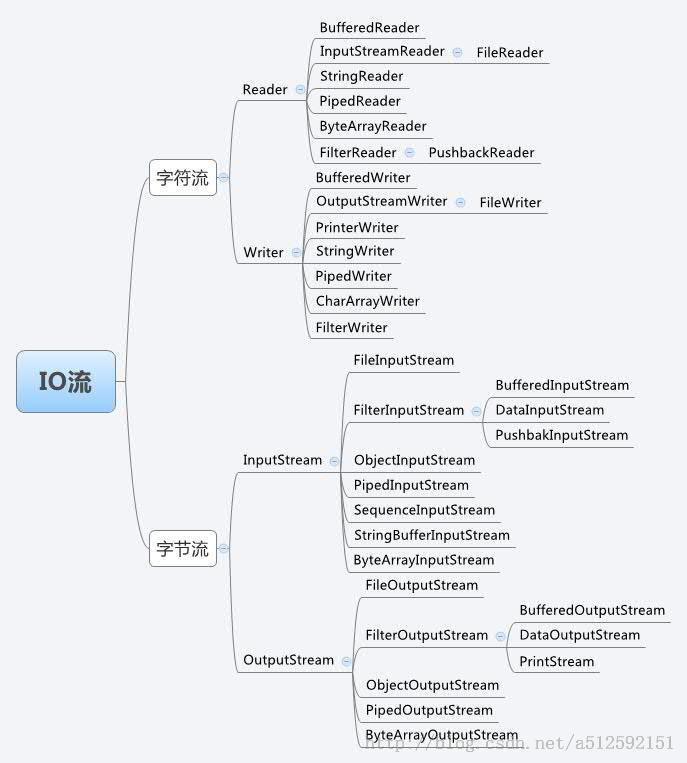
流的概念和作用
流是一组有顺序的,有起点和终点的字节集合,是对数据传输的总称或抽象。即数据在两设备间的传输称为流,流的本质是数据传输,根据数据传输特性将流抽象为各种类,方便更直观的进行数据操作。
IO流的分类
根据处理数据类型的不同分为:字符流和字节流
根据数据流向不同分为:输入流和输出流
- 字符流和字节流
字符流的由来: 因为数据编码的不同,而有了对字符进行高效操作的流对象。本质其实就是基于字节流读取时,去查了指定的码表。字节流和字符流的区别:
(1)读写单位不同:字节流以字节(8bit)为单位,字符流以字符为单位,根据码表映射字符,一次可能读多个字节。
(2)处理对象不同:字节流能处理所有类型的数据(如图片、avi等),而字符流只能处理字符类型的数据。
(3)字节流在操作的时候本身是不会用到缓冲区的,是文件本身的直接操作的;而字符流在操作的时候下后是会用到缓冲区的,是通过缓冲区来操作文件,我们将在下面验证这一点。
结论:优先选用字节流。首先因为硬盘上的所有文件都是以字节的形式进行传输或者保存的,包括图片等内容。但是字符只是在内存中才会形成的,所以在开发中,字节流使用广泛。 - 输入流和输出流
对输入流只能进行读操作,对输出流只能进行写操作,程序中需要根据待传输数据的不同特性而使用不同的流。
输入字节流InputStream
从输入字节流的继承图可以看出:
InputStream 是所有的输入字节流的父类,它是一个抽象类。
ByteArrayInputStream、StringBufferInputStream、FileInputStream 是三种基本的介质流,它们分别从Byte 数组、StringBuffer、和本地文件中读取数据。PipedInputStream 是从与其它线程共用的管道中读取数据,与Piped 相关的知识后续单独介绍。
ObjectInputStream 和所有FilterInputStream的子类都是装饰流(装饰器模式的主角)。意思是FileInputStream类可以通过一个String路径名创建一个对象,FileInputStream(String name)。而DataInputStream必须装饰一个类才能返回一个对象,DataInputStream(InputStream in)。
实例操作演示:
读取文件内容
/**
* 字节流
* 读文件内容
* */
import java.io.*;
public class FileTest{
public static void main(String[] args) throws IOException {
String fileName="D:"+File.separator+"FileTest.txt";
File f=new File(fileName);
InputStream in=new FileInputStream(f);
byte[] b=new byte[1024];
in.read(b);
in.close();
System.out.println(new String(b));
}
}注意:该示例中由于b字节数组长度为1024,如果文件较小,则会有大量填充空格。我们可以利用in.read(b);的返回值来设计程序,如下案例:
/**
* 字节流
* 读文件内容
* */
import java.io.*;
public class FileTest{
public static void main(String[] args) throws IOException {
String fileName="D:"+File.separator+"FileTest.txt";
File f=new File(fileName);
InputStream in=new FileInputStream(f);
byte[] b=new byte[1024];
int len=in.read(b);
in.close();
System.out.println("读入长度为:"+len);
System.out.println(new String(b,0,len));
}
}注意:观察上面的例子可以看出,我们预先申请了一个指定大小的空间,但是有时候这个空间可能太小,有时候可能太大,我们需要准确的大小,这样节省空间,那么我们可以这样做:
/**
* 字节流
* 读文件内容,节省空间
* */
import java.io.*;
public class FileTest{
public static void main(String[] args) throws IOException {
String fileName="D:"+File.separator+"FileTest.txt";
File f=new File(fileName);
InputStream in=new FileInputStream(f);
byte[] b=new byte[(int)f.length()];
in.read(b);
System.out.println("文件长度为:"+f.length());
in.close();
System.out.println(new String(b));
}
}注意:上面的几个例子都是在知道文件的内容多大,然后才展开的,有时候我们不知道文件有多大,这种情况下,我们需要判断是否独到文件的末尾。
/**
* 字节流
*读文件
* */
import java.io.*;
class FileTest{
public static void main(String[] args) throws IOException {
String fileName="D:"+File.separator+"FileTest.txt";
File f=new File(fileName);
InputStream in=new FileInputStream(f);
byte[] b=new byte[1024];
int count =0;
int temp=0;
while((temp=in.read())!=(-1)){
b[count++]=(byte)temp;
}
in.close();
System.out.println(new String(b));
}
}注意:当读到文件末尾的时候会返回-1.正常情况下是不会返回-1的。
DataInputStream类
import java.io.DataInputStream;
import java.io.File;
import java.io.FileInputStream;
import java.io.IOException;
public class DataOutputStreamDemo{
public static void main(String[] args) throws IOException{
File file = new File("d:" + File.separator +"hello.txt");
DataInputStream input = new DataInputStream(new FileInputStream(file));
char[] ch = new char[10];
int count = 0;
char temp;
while((temp = input.readChar()) != 'C'){
ch[count++] = temp;
}
System.out.println(ch);
}
}PushBackInputStream回退流操作
import java.io.ByteArrayInputStream;
import java.io.IOException;
import java.io.PushbackInputStream;
/**
* 回退流操作
* */
public class PushBackInputStreamDemo{
public static void main(String[] args) throwsIOException{
String str = "hello,rollenholt";
PushbackInputStream push = null;
ByteArrayInputStream bat = null;
bat = new ByteArrayInputStream(str.getBytes());
push = new PushbackInputStream(bat);
int temp = 0;
while((temp = push.read()) != -1){
if(temp == ','){
push.unread(temp);
temp = push.read();
System.out.print("(回退" +(char) temp + ") ");
}else{
System.out.print((char) temp);
}
}
}
}输出字节流OutputStream
IO 中输出字节流的继承图可见上图,可以看出:OutputStream 是所有的输出字节流的父类,它是一个抽象类。ByteArrayOutputStream、FileOutputStream是两种基本的介质流,它们分别向Byte 数组、和本地文件中写入数据。PipedOutputStream 是向与其它线程共用的管道中写入数据,ObjectOutputStream 和所有FilterOutputStream的子类都是装饰流。具体例子跟InputStream是对应的。
实例操作演示:
向文件中写入字符串
/**
* 字节流
* 向文件中写入字符串
* */
import java.io.*;
class hello{
public static void main(String[] args) throws IOException {
String fileName="D:"+File.separator+"hello.txt";
File f=new File(fileName);
OutputStream out =new FileOutputStream(f);
String str="Hello World";
byte[] b=str.getBytes();
out.write(b);
out.close();
}
}逐字节写入文件
/**
* 字节流
* 向文件中一个字节一个字节的写入字符串
* */
import java.io.*;
class hello{
public static void main(String[] args) throws IOException {
String fileName="D:"+File.separator+"hello.txt";
File f=new File(fileName);
OutputStream out =new FileOutputStream(f);
String str="Hello World!!";
byte[] b=str.getBytes();
for (int i = 0; i < b.length; i++) {
out.write(b[i]);
}
out.close();
}
}向文件中追加新内容
/**
* 字节流
* 向文件中追加新内容:
* */
import java.io.*;
class hello{
public static void main(String[] args) throws IOException {
String fileName="D:"+File.separator+"hello.txt";
File f=new File(fileName);
OutputStream out =new FileOutputStream(f,true);//true表示追加模式,否则为覆盖
String str="Rollen";
//String str="\r\nRollen"; 可以换行
byte[] b=str.getBytes();
for (int i = 0; i < b.length; i++) {
out.write(b[i]);
}
out.close();
}
}复制文件
/**
* 文件的复制
* */
import java.io.*;
class hello{
public static void main(String[] args) throws IOException {
if(args.length!=2){
System.out.println("命令行参数输入有误,请检查");
System.exit(1);
}
File file1=new File(args[0]);
File file2=new File(args[1]);
if(!file1.exists()){
System.out.println("被复制的文件不存在");
System.exit(1);
}
InputStream input=new FileInputStream(file1);
OutputStream output=new FileOutputStream(file2);
if((input!=null)&&(output!=null)){
int temp=0;
while((temp=input.read())!=(-1)){
output.write(temp);
}
}
input.close();
output.close();
}
}使用内存操作流将一个大写字母转化为小写字母
/**
* 使用内存操作流将一个大写字母转化为小写字母
* */
import java.io.*;
class hello{
public static void main(String[] args) throws IOException {
String str="ROLLENHOLT";
ByteArrayInputStream input=new ByteArrayInputStream(str.getBytes());
ByteArrayOutputStream output=new ByteArrayOutputStream();
int temp=0;
while((temp=input.read())!=-1){
char ch=(char)temp;
output.write(Character.toLowerCase(ch));
}
String outStr=output.toString();
input.close();
output.close();
System.out.println(outStr);
}
}






















 被折叠的 条评论
为什么被折叠?
被折叠的 条评论
为什么被折叠?








